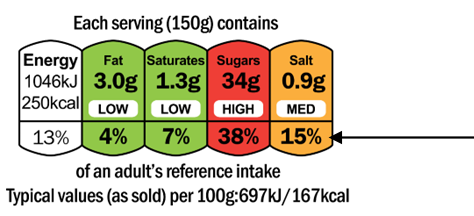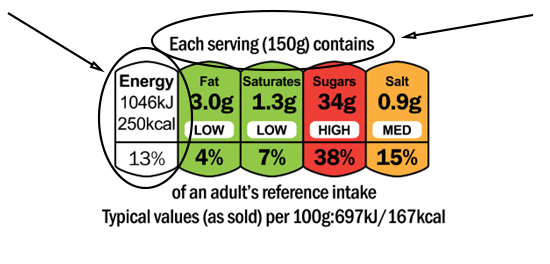Checking nutrition labels is a good way to compare products and make informed decisions about the food we’re consuming; this can help us lead a more balanced diet.
Back of pack labelling:
Most pre-packed foods in the UK will have a nutrition table on the back of pack. This will provide the nutrition information on a per 100g or per 100ml basis and may also provide information per portion.

Front of pack labelling (FOP):
Front of pack nutrition labelling is voluntary in the UK, however, has been widely adopted across the food industry.
A front of pack nutrition label may include the following:
- Energy (kJ and kcal)
OR
- Energy (kJ and kcal)
- Fat
- Saturated fat (saturates)
- Sugars
- Salt
- Reference intake of each nutrient

Understanding reference intakes
These numbers represent the reference intake (%RI) of each nutrient. So, this product contains 15% of the maximum salt guideline an adult should be eating per day. RI should be used as a guideline and not a target. Considering the %RI along with the colour coding can be useful in helping you make an informed choice.

Know your colours
Traffic light labelling can help you make decisions at a glance and are particularly helpful when comparing between products that are similar.
The red, amber and green traffic light colour coding show us if a product is high, medium or low in fat, saturates, sugars and salt.
Red front of pack labelling doesn’t mean you cannot eat these foods, but you should be mindful of how often you are choosing red front of pack foods.
Aim to choose foods with fewer red front of pack labels as this can help you achieve a healthier diet.
Know your calories
Energy can be expressed in both kcal and KJ.
You can read a food label to find out how many calories are in the food you’re consuming.
On average women need around 2,000 calories per day (8,400KJ) and men need around 2,500 calories per day (10,500KJ).

Know your portion
Nutrition information will be provided on a specified portion, which will be highlighted above the nutrition panel. This may be expressed by weight or in a way that is easily understandable e.g. per bag.
